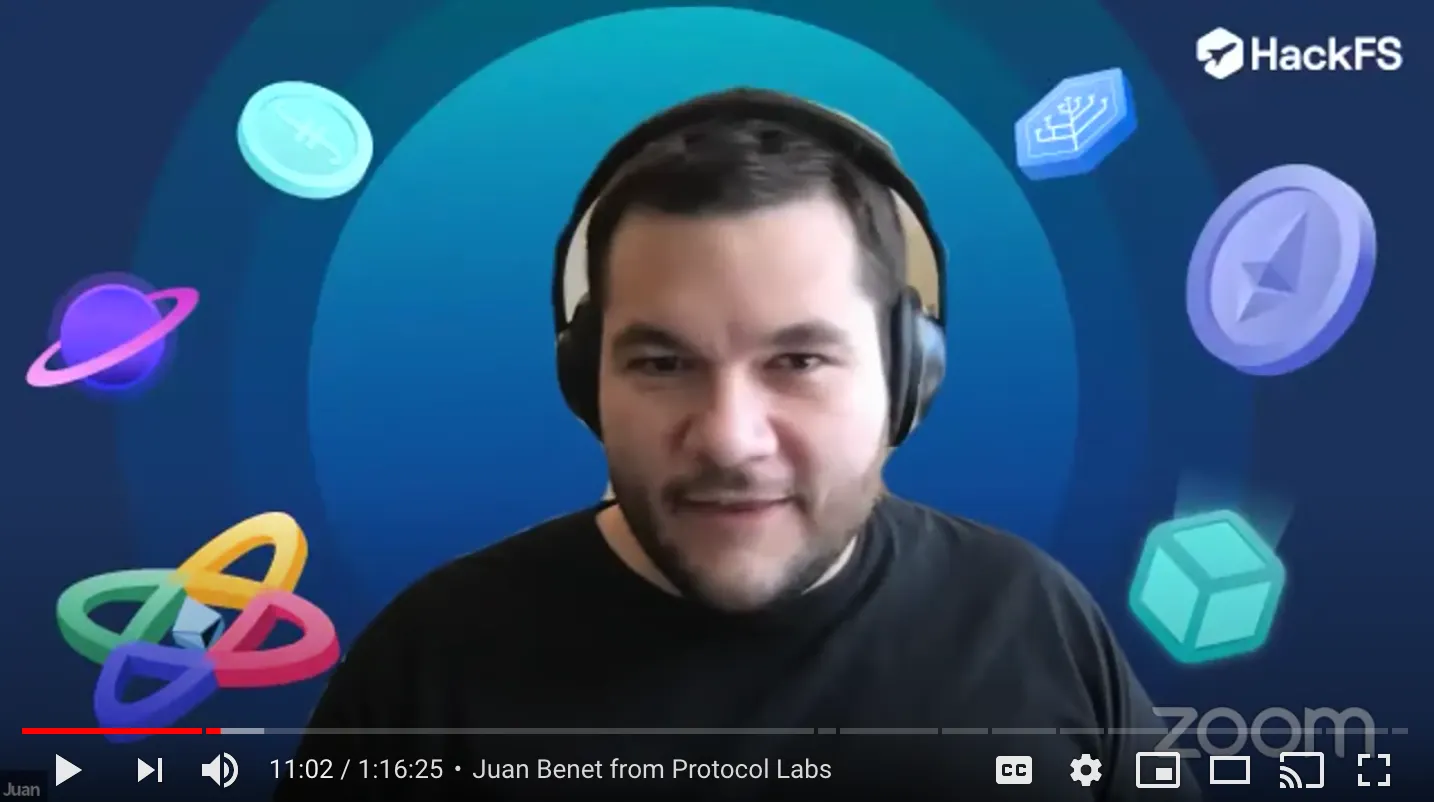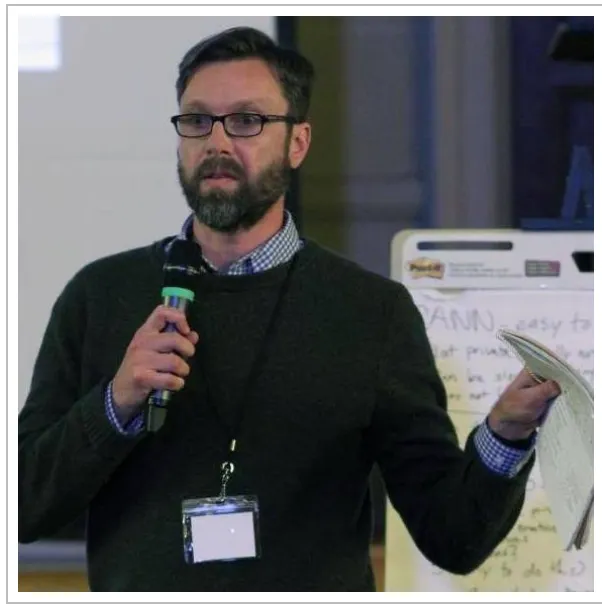We do the research, you get the alpha!
One by one, from all over the world, the builders log on to the live, HackFS webcast.
“Hi from Korea,” says Apple Kim, whose words appear in the virtual conference’s chat sidebar.
“Hei fra Oslo,” says Thor Kamphefner.
“Hello from Portland, Me,” says Matthew Johnson.
“Hi guys,” says Angel Molina, from somewhere in the world. “What a time to be alive XD.”
It’s July 6, yet another day in the endless doldrum of stay-at-home quarantine days—but this day, for these people at least, offers a bit of excitement: Today is the first day of HackFS, a four-week-long hackathon designed to help seed the newest, most anticipated blockchain in the Web3 world—Filecoin, due to launch next month.
If you’ve been following crypto for a while, you probably know a little about Filecoin. You might have heard that it raised $205 million during a record-breaking ICO in September 2017. That sum included $52 million it had raised in a presale from venture giants including Andreessen Horowitz, Sequoia Capital, and Union Square Ventures. Most important: it left the company comfortably positioned to execute its ambitious plans.
Which are? When most people try to explain what Filecoin is they resort to simple metaphors. ”Dropbox for the decentralized web,” is a frequent one, meaning decentralized cloud storage. “AirBnB for storing data,” is another, meaning anyone can effectively rent out to strangers unused space on their computers or servers, and get paid in FIL, its coin. (The coin, of course, incentivizes people to use the blockchain.)
These metaphors help get your head around what Filecoin is, but they oversimplify why people think this particular blockchain is such a big deal.
BFFs: Filecoin and Ethereum
They also don’t explain some apparent contradictions. Why for instance, is ConsenSys, an Ethereum incubator (and funder of an editorially independent Decrypt) working with Protocol Labs, the company that’s launching Filecoin? Ethereum is the second biggest blockchain in the world. Shouldn’t it be competing with Filecoin’s blockchain?
Yet Protocol is co-investing in ConsenSys’s Tachyon accelerator, on a “Filecoin Launchpad '' to help spur development on Protocol’s blockchain. Tachyon hasn’t teamed up with a co-investor before: “ConsenSys Labs’ Tachyon accelerator will be unique this year in that it will be co-supported by Protocol Labs,” Consensys said in its announcement last month. Likewise, ETHGlobal, which tends to sponsor Ethereum-based hackathons, is, along with Protocol Labs, co-sponsoring HackFS.
It turns out that Filecoin and Ethereum go together as if they are components of the same computer.
That’s not just another metaphor: Ethereum’s ambition has been to create a decentralized “world computer” atop the Internet—its blockchain is all about smart contracts, the basis for dapps. While Ethereum might supply the compute power of Web 3—what the blockchain’s co-founder, Joseph Lubin describes as its “trusted transactions and guaranteed execution of agreements”—the Filecoin blockchain will supply its memory.
“Ethereum applications require less expensive storage than Ethereum can and should supply, and in greater quantities,” Lubin later explained in an interview. “This is where IPFS and Filecoin are perfect complements to Ethereum.”
IPFS—the Interplanetary File System, another Protocol Labs project, is the decentralized scaffolding that the Filecoin blockchain is built on, and where the actual storage and retrieval of data occurs. (The Filecoin blockchain is the ledger of those storage-based transactions.) In some ways, it’s useful to visualize IPFS as Web3; it's a layer on the Internet connecting nodes in a decentralized, peer-to-peer mesh.
Filecoin was initially going to be built on the Ethereum blockchain, “but after deeper analysis, it became clear that they needed their own blockchain network as the ‘proof of work’ functions that they required were of a very different nature than what Ethereum used and were unique to the storage application and medium,” Lubin said.
“Filecoin is an ideal example of why the world needs different kinds of blockchains to subserve different aspects of IT infrastructure,” he added.
Which gets us back to ETHGlobal and HackFS, which officially ended last week. A panel of judges has concluded its judging, and the prize money will be awarded Tuesday. And, if all goes according to plan, FIlecoin will launch in late September.
In the meantime, the builders are getting ready and Juan Benet, who founded Protocol Labs, is rallying the troops and hunkering down for the launch of the season...
Our new superpowers explained at HackFS

“We live in an incredibly unprecedented time,” Benet told the HackFS viewers on its opening day. “In the last 80 years, computing has transformed humanity. We have superpowers now that, really, our ancestors would not be able to distinguish from magic.”
In Benet’s view, the web allows us to continually upgrade and evolve these “superpowers,” the software tools that potentially benefit us all. And that’s what’s happening right now: A massive upgrade is underway.
Benet takes the audience through his presentation. Where Web 1.0 was “read only”— we could search for things on the static web, and find stuff on places like Amazon and eBay—Web 2.0 is readable and writable. That gave rise to social networks that allowed us to interact, in our browsers, with data and of course, each other.
“Web3 is the next iteration of this fundamental superpower granting machinery,” says Benet. The superpower it bestows is that it “takes the web from being a read-write medium to finally being a trustable medium by adding verifiability.”
Benet says that the newest iteration of the web will be trustable “by default.” The underlying math and mechanics of the decentralized systems that power Web3 will help transition us from today’s chaotic, balkanized net to a world in which our data is protected, controlled by us, immutable and verifiably true.
The 75 different projects that 380 devs are working on at HackFS offer a pretty good sampling of the kinds of superpowers that await us. Here are a few.
Omo sapiens roam HackFS

Hello, from Munich!
HackFSers Philipp Bartels and Samuel Andert met at a hackathon a few years ago and hit it off—”we both really enjoyed going into deep abstract conversations,” recalls Andert, whose day job is handling data storage for the movie business.
Adds Bartels, a long-time dev in search of the perfect startup: “We are both guys who want to optimize each process. We want to build the ultimate tool to optimize every process you can imagine.”
That does indeed sound pretty abstract, albeit awesome. Andert elaborates: It’s currently too complex for most people to build their own decentralized applications. The Web3 world would be better if biz devs and product devs, in particular, could hack a prototype together, but “it’s still really hard to pull all the modules together to create a dapp.”
So for the past year or so, the friends have been hacking away on a project they call Omo F (the name refers to the predecessor of the first homo sapien.) Omo is a platform for helping cobble together the different modules needed to get a dapp up and running,
“During the hackathon, we’re just concentrating on one specific use case,” says Andert. “Let’s talk about the proof of concept system we’re building in the hackathon, ja?”
Andert and Bartels are fans of Gnosis founder Martin Köppelmann, who is working on a personal token-based “unconditional basic income” project called Circles. Circles, which launches in a few months, allows people to mint their own personal currency and pay each other via the trusted friend groups, or Circles, they create.
Koppelman called Andert in the spring with a challenge: “Find strategies to make Circles usable in the real economy.” Challenge accepted!
The Omo team is using its dapp-building platform to create “a funding platform. It’s like Patreon on Circles,” says Andert.
So what does this have to do with Filecoin? “Circles has a big challenge,” he explains. “Even Circles needs data storage.” Users will need to create accounts, with names, addresses and other private info. What Filecoin (and the Interplanetary File System, the Protocol Labs storage scaffolding that the Filecoin blockchain is built on) makes possible is that data can be stored and accessed without Omo or any other middle man getting in the way.
Says Andert: “Every user and project starter has all their data under their own control, and it’s never going through our platform. They just have their own private keys on their devices; we will never access that data.”
Best of all, he says, the whole Circles-alternative-to-Patreon platform “will be decentralized and can be reused by other starters, independent of us. It’s just infrastructure.”
Andert and Bartels are optimistic their prototype will be done by the end of HackFS: “We have the Circles payments integrated and we have a few user interfaces that we are wiring up to the backend.” (You can see a video demo of their project here.)
“I believe we can make it,” says Bartels.
A world-wide decentralized archive

Greetings from Vancouver!
In a remote cabin somewhere in Canada, Peter Van Garderen is burning through his monthly data allotment. During a mobile phone conversation, to preserve data, he chats about his HackFS project: He and his five-person team are creating a gateway to make it easier for Python users to use Filecoin. (Python is a relatively easy to use programming language for creating Web apps, among other things.)
That, anyway, is the immediate objective at hand. The reason the gateway will be useful is to make it easier for digital archivists, many of whom use Python, to store all manner of stuff on the decentralized web. “My long-term motivation is to build out a decentralized digital preservation solution for archives and libraries,” Van Garderen explains.
Art Richards, a product guy and fellow visionary on the team describes Van Garderen as the “leadership and vision” for Pygate. Richards is based in Berlin; the other devs are in Nigeria and London.
“Peter’s vision, and ours as a team, is to get the first part of a data abstraction on top of Pygate, the Python gRPC client,” explains Richards. “That’s where the fun and difficulty comes in. We understood that the first idea was to get the Pygate client done—the next step is to show how this would actually get used. What would the users be doing? How would they interface with this?”
Van Garderen’s obsession in life is digital preservation. Many people erroneously believed that once information was digitally rendered, we’d be able to access it forever. But that turned out to be yet another busted dream.
Anyone remember WordStar? One of the first word processing systems for personal computers, it debuted on the CP/M-80-based desktops that preceded MS-DOS PCs. Imagine coming across important documents written in that application. This is the kind of thing that keeps people like Van Garderen up at night. There are other problems too, including digitized documents archived on outdated storage media such as floppy disks and even people leaving stuff on sunsetting cloud-based systems then failing to move them.
“It’s a wicked problem because there are so many layers to it,” Van Garderen says. That’s why “the next wave for digital preservation is to take advantage of decentralization.”
Filecoin, of course, won’t solve compatibility issues (such as translating a WordStar doc) but it ought to go a long way toward solving the storage problem. “You can incentivize miners to store multiple copies of your data for you,” he says.
Still, Filecoin is not without risks. One of the assumptions of the blockchain network is that enough people will participate in the economy, providing hard-drive storage in exchange for FIL, that the price of decentralized storage will be cheaper than the Web2 incumbents. “What if it turns out the market price for storage on Filecoin is no better than on Amazon Web Services?” mused Richards?
That’s another reason the team is here: To get a better sense of whether Filecoin will work according to plan.
Meanwhile, though, the team has already fulfilled its preliminary objective: “I think we’re already a success,” Richards says. “The goal of bringing Filecoin to Python devs is already being met.”
The poet of ‘pristine data’

Greetings from suburban Philadelphia!
You don’t meet a lot of poets on the coding side of technology, but that’s what Thomas Jay Rush is, and how he spent a chunk of his recent career.
Rush says he started out in computers “when I was 2,” got an undergraduate degree in Mathematics and, like many of us OGs, fell hard for the promises whispered by the nascent Web.
“Young people’s minds were on fire with the dream of the early World Wide Web,” he recalls. (Tell me about it.)
With the advent of the Web, there was a belief that “everyone has a voice. Everyone can speak, everyone can get their ideas out.” And for a brief and glorious moment, “it kind of happened, but then it fell back down.”
Rush got to capitalize a bit on those early days of Web1 empowerment: He built a piece of software that allowed people to share their calendars and schedule appointments over the Web. People found his one-person business and it turned into a decent living; many still use his Calendars for the Web software to this day, 18 years later. That’s how he financed his foray into poetry.
Still, as the larger dream of Web1 got crushed by the likes of Facebook and the rise of brutalist, centralized companies that were anathema to human empowerment, he went back to school in 2008 for a creative writing degree and became a poet and teacher.
Bitcoin got him interested in technology again—the mathematics of encryption has always been a passion of his—and then, with the advent of Ethereum, he fell in love with the whispered promises of the Web again.
Recalls Rush: “I haven’t written a single word of poetry since I got involved in Ethereum.,” he says, adding that “hearing about Ethereum, it was almost the same conversation we were having in the 1990s about how we were going to change the world.”
Now he works upstairs in the book-lined office of his home, while two Linux machines, each with eight terabytes of storage and its own Ethereum archive node, bring Ethereum’s blockchain data to him for his perusal. He says he works most days from 5 a.m. to midnight. His HackFS project is called The Unchained Index, which he describes as “an freely available, verified index of appearances of addresses.”
This is not just poetry, though Rush’s explanation of his work is hardly prosaic. Though the math of the blockchain may describe a beautiful, perfect-truth, data, in reality, it can be a disappointment, he says. On Ethereum’s blockchain “you have this beautiful pristine data, but you can’t get to it unless you go through a third party such as Etherscan or Infura.”
This bugs him. “I thought the whole point of decentralization was to decentralize, and here are these two big companies in the middle of it. For all we know—and I’m not casting aspersions—by the time it gets down to the users it could be wrong.”
His TrueBlocks protocol is trying to ensure that pristine data follows a verifiable path from the chain to the end-user—without a middle man. “We’re building an index of addresses on the chain,” he says, referring to the header-type information in a transaction such as the Sender and Recipient. “We capture every address in the transaction. Then we build an index to capture every instance of where every address appears. We call these things ‘appearances.’”
Of course, TrueBlock’s index itself could be flawed. Rush has already dealt with that: “We include an immutable reference to the code used to derive the index in the index itself,” Rush says. “This allows anyone who receives the data to verify it themselves if they wish to. We then push that data out to IPFS. IPFS has all the qualities I love to store immutable, derived data. It’s the perfect place for this data.
For instance, he says, “the data has been agreed to by thousands of computers (miners) around the world, data that’s been hashed so it cannot be altered. End-users today cannot get to pristine data.”
So why is this important?
“We think this pristine data can foster naturally occurring, ‘magic’ communities. That, I think, is the true use case for blockchains.”
He explains. “I came into the space before the DAO had curators,” Rush says. “They were building unstoppable code with no ability to halt operation, no ability for anyone to exhibit more authority than anyone else in the community.”
The DAO was truly autonomous and decentralized, and “everyone was running their own node (because Infura didn’t exist).”
But shortly after The DAO was launched, “it became obvious that some people (very technical people) had way more information about what was happening than others, and the power dynamic where ‘everyone was on equal footing with none at advantage’ disappeared.” That problem has only worsened over time.
“Today, these ideas are all but gone. Smart contracts have ‘owners.’ DAOs are collections of people who’ve been ‘admitted’ to a membership group. People don’t even think of being permissionlessly in possession of insight into popular smart contracts. The only way to get data on a smart contract is to go to a website that is built by the same people who built the smart contract or Etherscan.”
Communities come alive when everyone has access to the same unalterable “truly transparent” data, “available to all members of a community without a third party—without even the developers themselves.”
Rush, like many of us, wants to fix the Web, and he thinks pristine data is the way to get the fundamentals right. “I hope we can not repeat the same mistakes we made,” he says. “That’s what’s driving me.”
The mother of invention at HackFS

Hello from New Hampshire!
Martha Roth has always loved science and learning about the world. After college she worked as a researcher at Dartmouth’s medical school, before taking off for a while to raise her three children. One of them, Andrew Hill, co-founded and is CEO of Textile, which makes open sources tools for Web3 devs.
That’s how she got interested in the decentralized Web—and why she wanted to participate in the hackathon. “I am very familiar with what my son does,” she says, “but I kind of wanted to know some other stuff. And I thought, 30 days immersed in a subject seemed like a pretty good deal for me—” here she chuckles. “Unfortunately after I got into it, I realized that I had to come up with a project!”
Roth has had macular degeneration all her life and by now, at 73, she is mostly blind, she says. She decided her contribution to HackSF would be blogging about it, which she did here, in a series of posts to Github.
“I’ve used the Internet since it started,” she says. “I used it when it turned into web1 and I used it when it turned into web2,” she says. She, like just about everyone else ast HackFS, doesn’t like what the Web has become: ”Someone is in charge and it isn’t me. I’m a self-sufficient individual and I like to be in charge. I like to know what I have and I don't like to share if I don't want to. I don’t like the idea that there is someone in there that can just whisk off with your stuff.”
“The Web,” she adds, “is centralized. There is no room for anyone else. But Web3 has plenty of room. Look at all the people that are interested in developing apps that they can own and control.”
Roth, who has seen it all pauses for a second, and says, “Now they might fail—but they might not fail.” And that, obviously, is what these Web3 builders hope. What a time to be alive.





